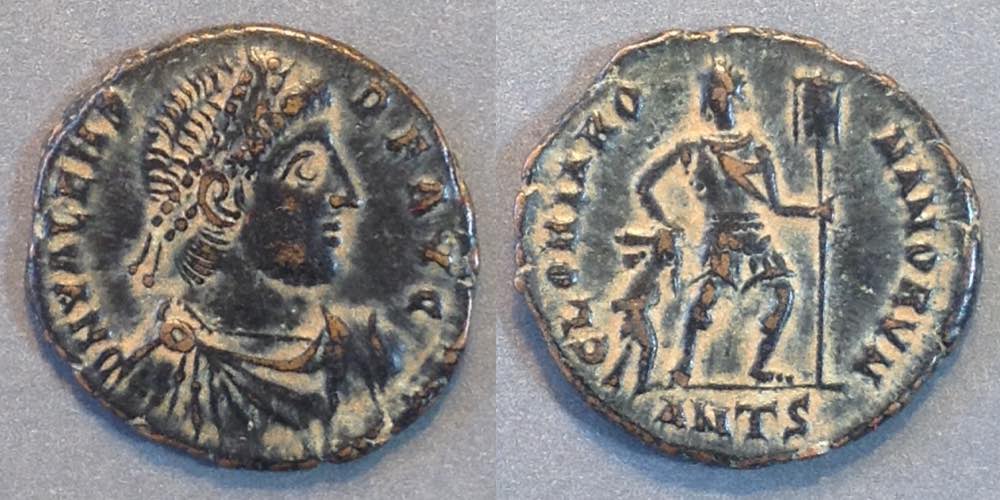
A Complete List
Valentinian I through Theodosius II and Valentinian III
Esty's Guide to Late Roman AE Coin Types, AD 364-450: 
A Complete List
Valentinian I through Theodosius II and Valentinian III
A resource for collectors of Late Roman AE coins.
Types, rarities, and commentary.
Organized by emperor.
Organized by reverse type .
This is a fun area to collect because the history is interesting and the coins are among the least expensive of all ancient coins, while there are many rare types that can be found occasionally to keep you interested (for four decades, in my case!). To the upper right is a coin of the very common Type 5 of the emperor Valens (AD 364-378).
Links to the other emperors and their wives (in chronological order) (in alphabetical order)
(This is an educational site, not a sale site. If you want to see coins like these for sale, look here.)
What's New? 2024, August 2: Irregular font sizes corrected.
Search (e.g. for legends) with "Control-F".
Contents: This is a huge site with over 100 pages. Find what you want by starting here.
Images of all reverse types (just below)
Type sets for each emperor. (Emperors listed chronologically or, alphabetically, linked to their types)
Information about coins of the period, including
What do all those abbreviations (like "AE3") mean?
What's in all those tables? How do I use them?
A timeline of events that determine who issued coins when (names and dates). Map of the empire in 364.
Four TABLES of types and issuers, with links to discussion and images.
Table 1 (364-378) images, Table 1 (Types 1-12) (Valentinian to the death of Valens, 364 - 375. This begins RIC IX.)
Table 2 (378-395) images, Table 2 (Types 13-43) (ending with the death of Theodosius, 375 - 395. This ends RIC IX.)
Table 3 (395-423) images, Table 3 (Types 44-59) (ending with the death of Honorius, 395 - 423. This begins RIC X.)
Table 4 (423-450) images, Table 4 (Types 60-81) (Theodosius II and Valentinian III, 423 - 450. These are in RIC X.)
Table contents outlined and explained.
Reference works (both numismatic and history books).
Copyright (c) Warren W. Esty. All rights reserved. You are encouraged to print the tables for personal use as a collecting checklist, and for that you have my permission. However, no other reproduction is allowed without my explicit written permission (which I have always given to people who asked).
If you would like to discuss the coins of this time period, e-mail me at: 
Images of most reverse types (in chronological order): Click on the images to go to the corresponding page. N.B. Images preserve relative sizes.
Types 1-12 (364 - 378) Valentinian, Valens, Gratian, Valentinian II, Theodosius I, Arcadius. These are in RIC IX:
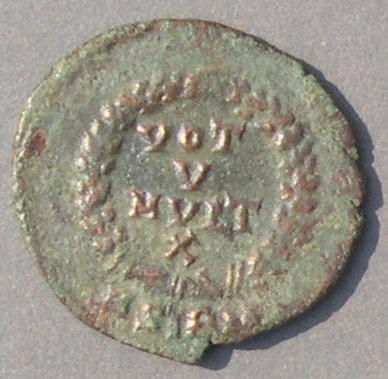 |
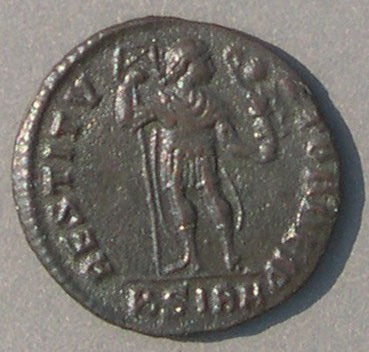 |
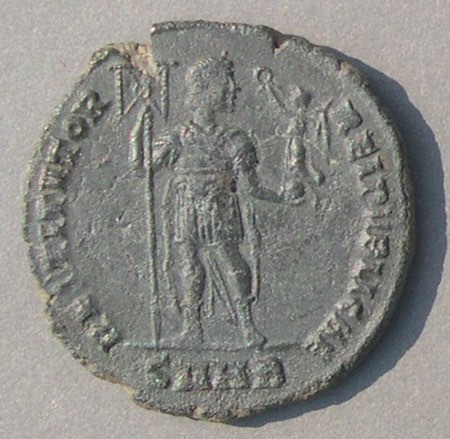 |
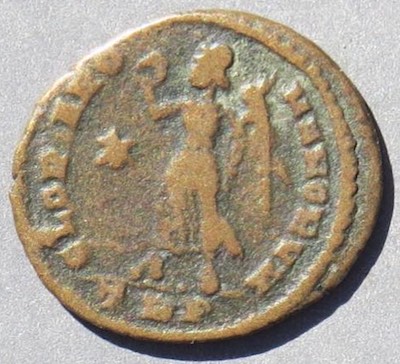 |
|
VOT V |
RESTITVTOR REIP |
RESTITVTOR REIPVBLICAE | GLORIA ROMANORVM |
| Type 1 | Type 2 | Type 3 | Type 4 (cf. 6) |
 |
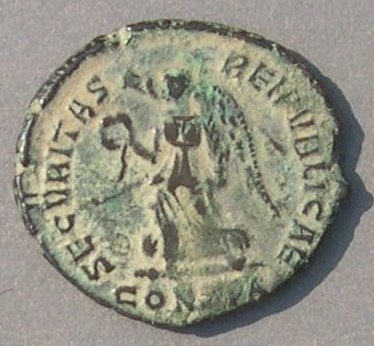 |
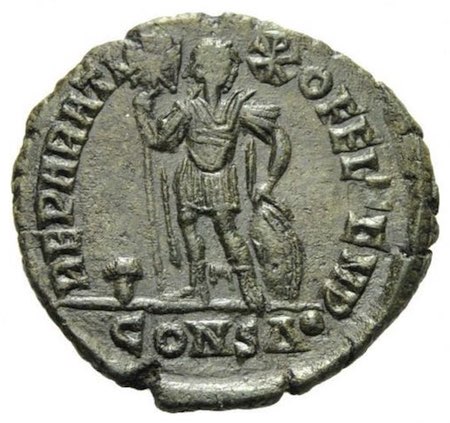 |
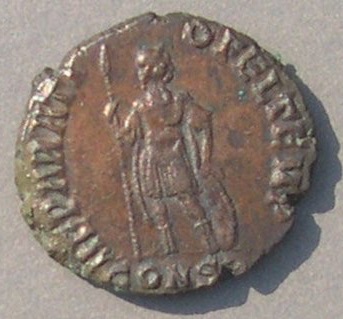 |
| GLORIA ROMANORVM |
SECVRITAS REIPVBLICAE | REPARATIO FEL TEMP |
REPARATIO FEL TEMP |
| Type 5 | Type 6 | Type 7 | Type 8 |
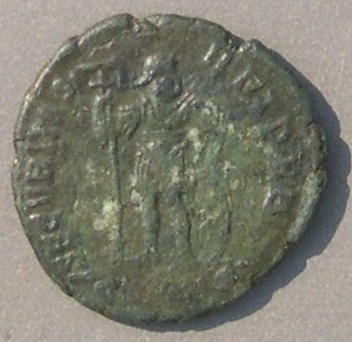 |
 |
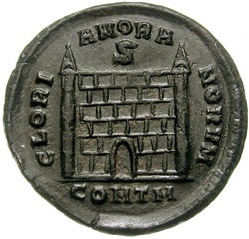 |
 |
| SECVRITAS REIPVB |
GLORIA NOVI |
GLORIA ROMANORVM |
FELICITAS |
| Type 8A | Type 9 | Type 10 | Type 11 |
Types 1-12 are in Table 1. Types 13-43 are in Table 2.
Types 13-29 (378 - 395) Gratian, Valentinian II, Theodosius, Magnus Maximus, Flavius Victor, Arcadius: These are in RIC IX.
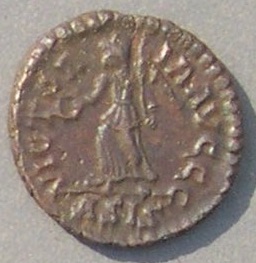 |
 |
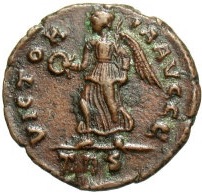 |
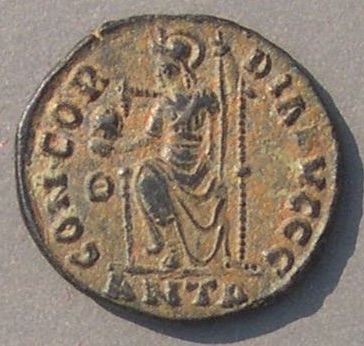 |
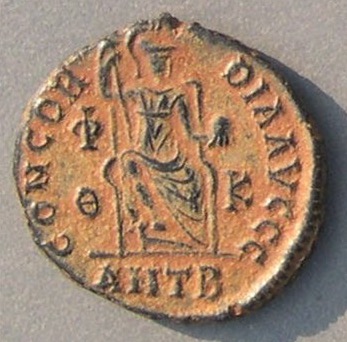 |
|
VICTORIA |
VRBS ROMA |
VICTORIA AVGGG |
CONCORDIA AVGGG |
CONCORDIA AVGGG |
| Type 12 (AE4) | Type 13 | Type 14 (AE3) | Type 15 | Type 16 |
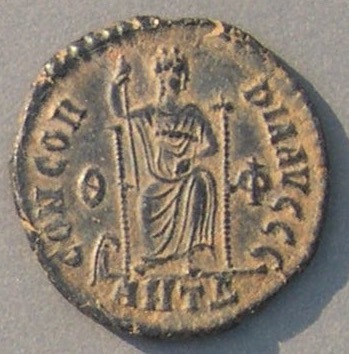 |
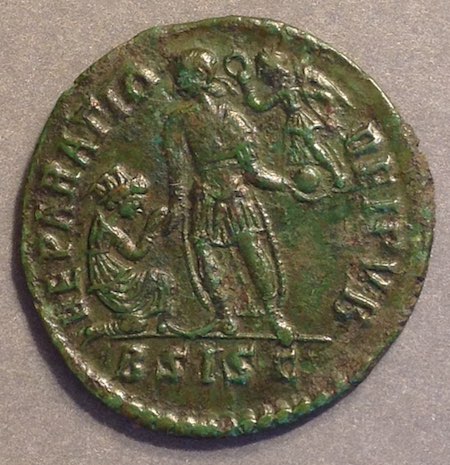 |
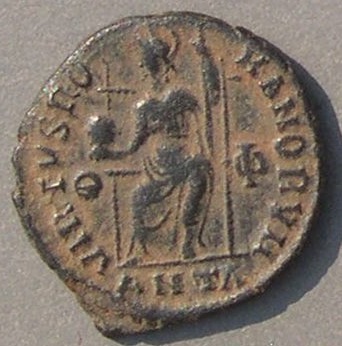 |
 |
|
CONCORDIA |
REPARATIO REIPVB |
VIRTVS ROMANORVM |
GLORIA ROMANORVM |
| Type 17 | Type 18 | Type 19 | Type 20 |
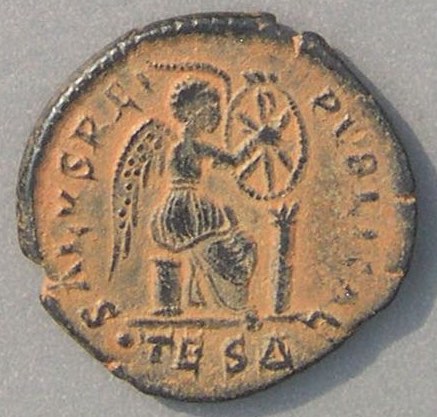 |
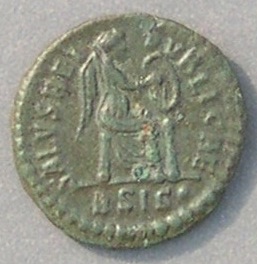 |
 |
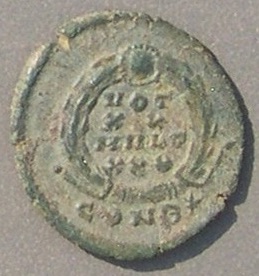 |
|
SALVS |
SALVS REIPVBLICAE |
SALVS REIPVBLICAE |
VOT XX MVLT XXX |
| Type 21 | Type 22 | Type 23 | Type 24 |
 |
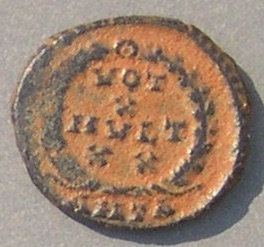 |
 |
 |
 |
|
VOT XV |
VOT X MVLT XX |
VICTORIA AVGGG |
VOT V MVLT X |
VOT V |
| Type 25 | Type 26 | Type 27 | Type 28 | Type 29 |
Types 13-29 are in the first half of Table 2. Types 30-43 are in the second half of Table 2.
Types 13-43 (378 - 395) Gratian, Valentinian II, Theodosius, Magnus Maximus, Flavius Victor, Arcadius): These are in RIC IX.
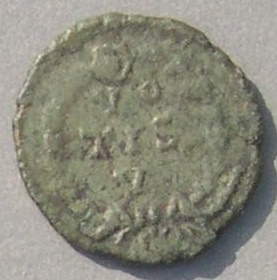 |
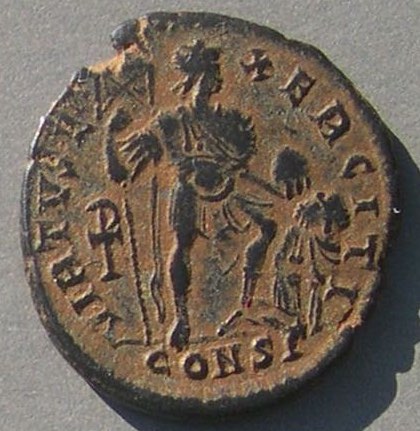 |
 |
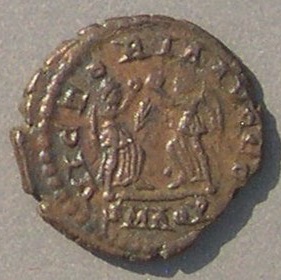 |
|
VOT IS |
VIRTVS EXERCITI |
VICTORIA AVGG |
VICTORIA AVGGG |
| Type 30 | Type 31 | Type 32 | Type 33 |
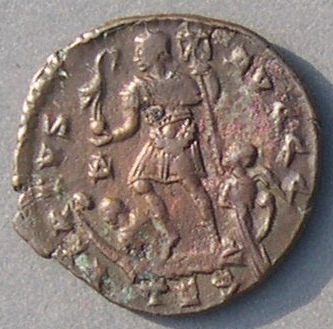 |
 |
 |
|
VIRTVS |
GLORIA ROMANORVM (only Arcadius) |
SPES ROMANORVM |
| Type 34 | Type 35 | Type 36 |
 |
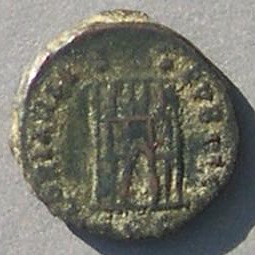 |
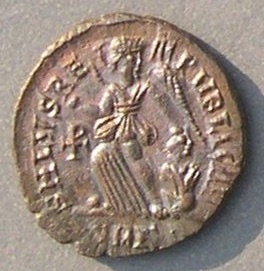 |
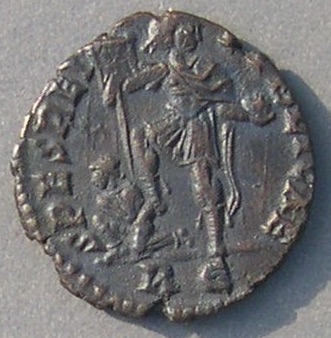 |
| GLORIA REPVBLICE |
GLORIA |
SALVS REPVBLICAE |
SPES |
| Type 37 | Type 38 | Type 39 |
Type 40 |
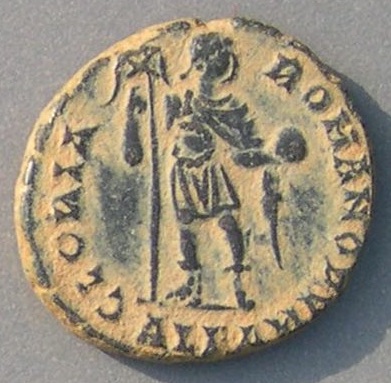 |
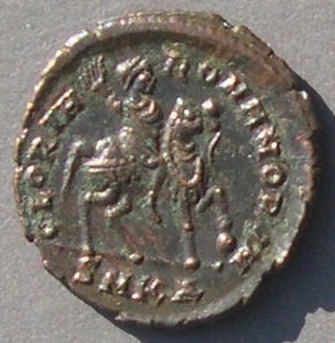 |
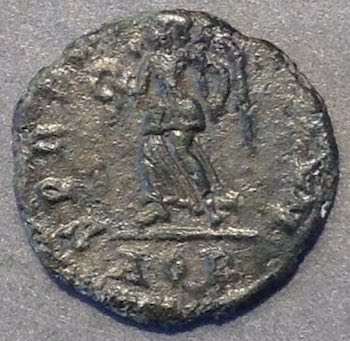 |
[no image] Victory Advancing left Type 44 AE4 |
| GLORIA ROMANORVM |
GLORIA |
SPES ROMANORVM |
VICTORIA |
| Type 41 | Type 42 | Type 43 |
Type 44 |
Types 30-43 above are in the second half of Table 2.
Types 44-59 begin after the death of Theodosius in 395 and are in Table 3. They are in RIC X.
Types 44-59 (395 - 423) Arcadius, Honorius, Theodosius II, Valentinian III.
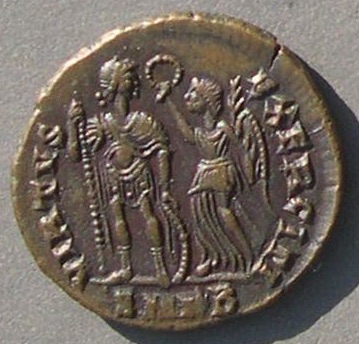 |
 |
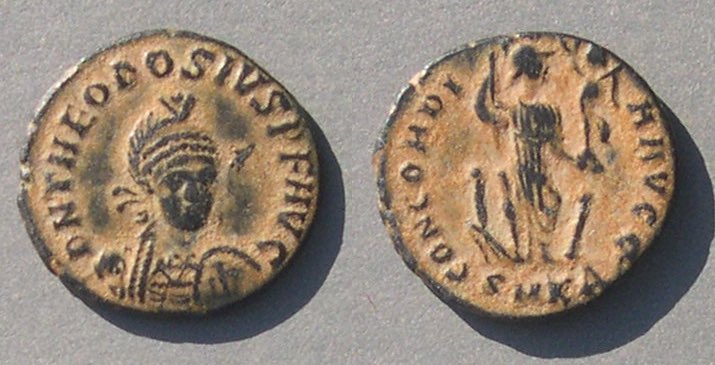 |
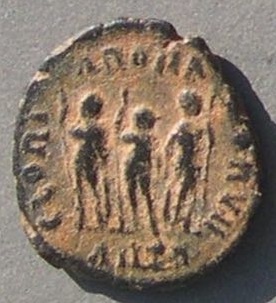 |
| VIRTVS EXERCITI |
CONCORDIA |
CONCORDIA AVGG |
GLORIA |
| Type 45 | Type 46 | Type 47 |
Type 48 |
 |
[no image] Victory Advancing left Type 50 AE4 |
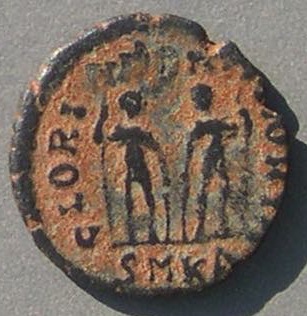 |
 |
[no image] Emperor with standard and shield Type 53 AE3 |
|
VRBS ROMA |
VICTORIA ROMANORVM |
GLORIA ROMANORVM |
GLORIA ROMANORVM |
GLORIA ROMANORVM |
| Type 49 | Type 50 | Type 51 | Type 52 | Type 53 |
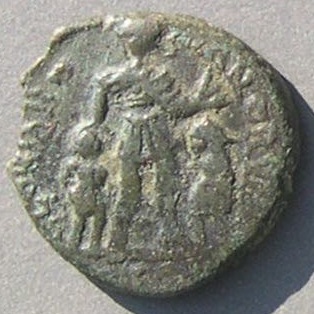 |
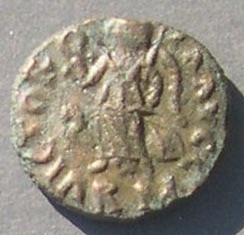 |
 |
 |
[no image] Emperor raises female Type 58 AE2 (only Maximus of Barcelona) |
|
GLORIA |
VICTORIA AVGG(G) |
SALVS REIPVBLICAE |
GLORIA ROMANORVM |
VICTORIA AVGG(G) |
| Type 54 | Type 55 | Type 56 | Type 57 |
Type 58 |
Types 60-72 are in the first half of Table 4. Types 73-83 are in the second half of Table 4.
Types 60-83. Theodosius II, Valentinian III. See Table 4. These are in RIC X
| [no image] Victory adv. left Type 59 Small AE3 (only Maximus of Barcelona) |
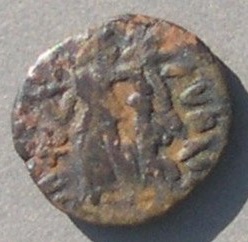 |
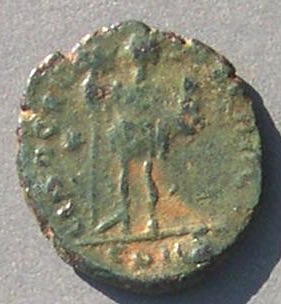 |
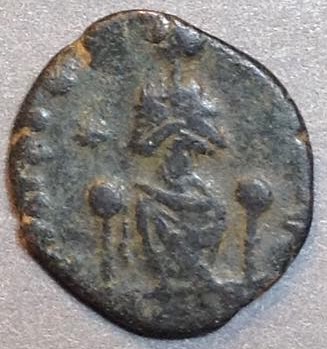 |
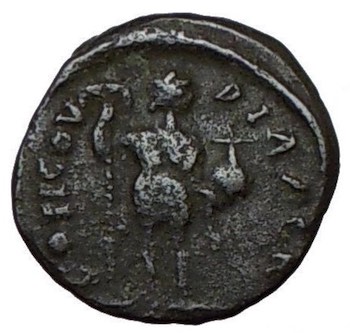 |
|
VICTORIA |
SALVS REIPVBLICAE |
GLORIA ROMANORVM |
GLORIA ROMANORVM |
GLORIA ROMANORVM |
| Type 59 | Type 60 (cf 66) | Type 61 | Type 62 | Type 63 |
| [no image] Emperor and shield Type 64 AE4 |
 |
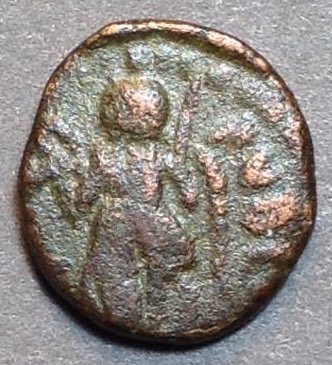 |
 |
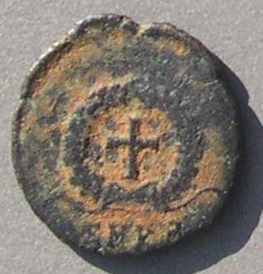 |
|
VRTVS [sic] |
SALVS REIPVBLICAE (thick cross) |
SALVS REIPVBLICAE |
CONCORDIA AVG |
(no legend, Cross in wreath) |
| Type 64 | Type 65 | Type 66 (cf 60) | Type 67 |
Type 68 |
[no image] Emperor with trophy drags captive Type 69 AE4 (only Valentinian III) |
[no image] Emperor with wreath drags captive Type 70 AE4 (only Valentinian III) |
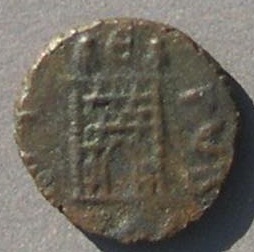 |
 |
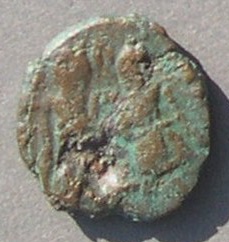 |
|
VICTORIA |
VICTORIA AVGG |
VOT PVB |
VOT XX |
VICTORIA AVG |
| Type 69 | Type 70 | Type 71 | Type 72 |
Type 73 |
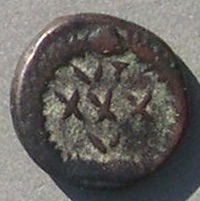 |
 |
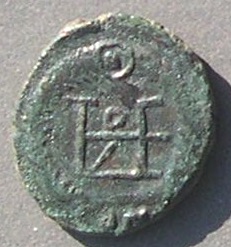 |
 |
 |
|
VT XXX |
CONCORDIA AGV [sic] |
Monogram of Theodosius II |
VOT XV |
ROMA (campgate) |
| Type 74 | Type 75 | Type 76 | Type 77 | Type 83 |
Types 78 to 82 are very rare and not pictured. Each is a tiny and very poorly produced AE4 of Valentinian III. Their legends are never clear. Table 4 has a short description of each. Page links: Type 78, Type 79, Type 80, Type 81, Type 82.
Table 1: Types initiated 364-378 (period from Valentinian I, 364, ending with the death of Valens in 378) (Table 1 images)
Key to the tables.
| AE | reverse types Table 1 | ID | date | V | Vn | G | V2 | T | MM | A | H | T2 | V3 | other |
| 3 | VOT / V / MVLT / X in wreath | 1 | 364 | S | ||||||||||
| 3 | RESTITVTOR REIP emp stg w vict on globe | 2 | 364-367 | C | C | |||||||||
| 1 | RESTITVTOR REIPVBLICAE emp stg | 3 | 364-367 | S | 2 | 4 | ||||||||
| 3 | GLORIA ROMANORVM Vict adv left | 4 | 364-378 | 3 | 2 | 2 | 3 | |||||||
| 3 | GLORIA ROMANORVM emp. drags captive | 5 | 364-388 | C | C | C | C | C | S | |||||
| 3 | SECVRITAS REIPVBLICAE Vict adv left | 6 | 364-378 | C | C | C | C | |||||||
| 3 | REPARATIO FEL TEMP (bust left) emp chi rho | 7 | 365-366 | P-S | ||||||||||
| 3 | REPARATIO FEL TEMP (bust right, no chi-rho) | 8 | 365-366 | P-S | ||||||||||
| 3 | SECVRITAS REIBVP emp. front with standard | 8A | 365-366 | P-2 | ||||||||||
| 3 | GLORIA NOVI SAECVLI emp w labarum | 9 | 367-375 | S | ||||||||||
| 2 | GLORIA ROMANORVM camp gate | 10 | 367-375 | 2 | 2 | 2 | ||||||||
| 3 | FELICITAS ROMANORVM Vict adv left | 11 | 375-378 | 3 | 2 | 5 | ||||||||
| 4 | VICTORIA AVGGG Victory adv left | 12 | 375-395 | 4 | 4 | C | C | C | 3 | E-3 | ||||
| AE | reverse type [end of Table 1] | ID | date | V | Vn | G | V2 | T | A | H | other |
Go to a supplement listing very rare but attested types that are possibly mint errors or recording errors.
Go to: Emperor list (chronological), (alphabetical).
This was Table 1 (364-378) images, Table 1 (types 1-12) (Valentinian to the death of Valens)
Table 2 (378-395) images, Table 2 (types 13-43) (ending with the death of Theodosius)
Table 3 (395-423) images, Table 3 (types 44-59) (ending with the death of Honorius)
Table 4 (423-450) images, Table 4 (types 60-81) (Theodosius II and Valentinian III).
Go to the Table of Contents, near the top of the page.
Rarity notes: There were huge numbers of types 1-8 coming out of the Balkans after the Iron Curtain fell and the old RIC IX rarity ratings from 1933 are not up to date for any mint that sent coins to the Balkans, particularly Siscia, Thessalonica, and Sirmium, as well as, to a lesser extent, other nearby eastern mints. Therefore, I have changed some of the ratings. Those changed to more common are in this color (dark red). Those changed to rarer are in this color (green). Types 7 and 8, of Procopius, were "R2" or "R3" in RIC, but are now common. However, they are still "scarce" in nice condition, hence the "S" in the rarity column.
Type notes:
4 has the type of SECVRITAS REPVBLICAE with the legend GLORIA ROMANORVM
8A, a relatively recent discovery, was not listed in RIC.
11 has the type of SECVRITAS REPVBLICAE but the legend FELICITAS ROMANORVM.
12 VICTORIA AVGGG, is very similar to several other types in the tables. Type 12 is difficult to distinguish from Type 44, which is a continuation of the same type at Trier with GG instead of GGG for a short while after the death of Theodosius. Type 14 is similar but distinctly larger. Type 27 is similar, but has 2 G's for Magnus Maximus. An example with GG for Theodosius is probably just an error. Type 55 is similar but cruder, usually with type too large for the flan.
Table 2: Types initiated 378-395 (After the death of Valens and before the death of Theodosius. This table finishes the types of RIC IX.) (Table 2 images)
Go to a supplement listing very rare but attested types that are possibly mint errors or recording errors.
Table 2 Type notes:
14 "VICTORIA AVGGG" is an AE3 of a type common as AE4 (type 12).
15 and 16 are very similar. On type type 16, Constantinopolis looks right and her foot rests on a tiny prow (left) and she holds a globe to the right. On type 15, Roma looks left and holds a globe to the left. There is a variant with no globe listed under type 16.
17 is just like the AE3 type 16, but smaller. It is only from one mint (Trier) and extremely rare. It cannot be a significant issue and I wonder if it is an ancient imitation.
20 is "irregular for Arcadius" and the two examples in DO have the "hand of God" obverse expected on type 35.
24 has an extremely rare variant: AE4. VOT / X / MVLT / XXX in wreath. RIC IX, Ant 57, "R5," which I have added in as type 24A.
27 for Magnus Maximus with two G's, is very similar to type 12 which has 3 G's.
29 "VOT / V" has at least one example with an engraver's error: VOT X
31 "VIRTVS EXERCITI": For Arcadius at Constantinople the obverse spells out the whole title "AVGVSTVS", but always as "AVGVSIVS" with "I" for "T". Reference works do not seem to acknowledge this. Is the substitution because the pronunciation was changing? Elsewhere, the usual "AVG" is found.
36 "SPES ROMANORVM, camp gate." This is the only type of Flavius Victor in AE.
37 and 38 are similar. Type 37 is AE3, "camp gate," has bust left and is "scarce" in RIC, but really is quite rare. It is an AE3 with the same reverse as type 38.
38 AE4, "camp gate," with bust right, has an AE3 version, type 37, with consular bust left.
39 AE4, "SALVS REPVBLICAE, Victory left drags captive" was issued over many years with minor variations treated as one type here. After AD 395 it has a chi-rho in field left. A cruder version with the same types was minted by Johannes for himself and Theodosius II (type 60).
Tables 2 and 2A complete the list of types in RIC IX, which ends at AD 395 with the death of Theodosius, part way through the reigns of Arcadius and Honorius. DO begins with all issues of Arcadius (beginning in 383) and Honorius (beginning in 393), but has no coins of Theodosius I. The types of Arcadius and Honorius in Table 2 can be found in both RIC IX and DO. RIC X resumes in 395 where RIC IX leaves off.
Go to the images from Table 2.
Table 3: Types initiated AD 395-423, after the death of Theodosius I and before Valentinian III.
Only Arcadius, Honorius, and Theodosius II. (These types are in RIC X and DO.)
Size note: AE3's and AE4's are of reduced sizes, so an "AE3" in this table is smaller than an AE3 from Tables 1 or 2. (Table 3 images)
| AE | reverse types Table 3 | ID | date | V | Vn | G | V2 | T | MM | A | H | T2 | V3 | other |
| 4 | VICTORIA AVGG Vict adv left | 44 | 395 | 2 | 2 | |||||||||
| 3 | VIRTVS EXERCITI Vict crowns emp | 45 | 395-401 | C | C | |||||||||
| 4 | CONCORDIA AVG(GG) cross | 46 | 395-408 | C | C | C | ||||||||
| 3 | CONCORDIA AVGG (facing bust) | 47 | 401-403 | S | S | S | ||||||||
| 3 | GLORIA ROMANORVM three emps, middle smaller | 48 | 403-408 | C | C | C | ||||||||
| 3 | VRBS ROMA FELIX Roma stg, hd. r | 49 | 404-408 | R | R | 2 | ||||||||
| 3 | VICTORIA ROMANORVM Vict adv l star in field | 50 | 409-410 | PA-3 | ||||||||||
| 3 | GLORIA ROMANORVM two emps standing | 51 | 408-423 | C | C | |||||||||
| 3 | GLORIA ROMANORVM two emps w globe | 52 | 408-423 | C | S | |||||||||
| 3 | GLORIA ROMANORVM emp w standard, shield | 53 | 411-415 | 2 | ||||||||||
| 3 | GLORIA ROMANORVM emp w 2 captives | 54 | 409-410 | R | ||||||||||
| 3-4 | VICTORIA AVGG(G) Vict. adv. l | 55 | 410-435 | S | 4 | S | J-4 | |||||||
| 3 | SALVS REIPVBLICAE Vict std, insc shield | 56 | 400-401 | Ex-S, Pu-4 | ||||||||||
| 3 | GLORIA ROMANORVM empress std facing | 57 | 402-404 | Ex-S | ||||||||||
| 2 | VICTORIA AVGGG emp raises female | 58 | 410-411 | Mx-4 | ||||||||||
| 3 | VICTORIA AVGGG Vict adv l | 59 | 410-411 | Mx-3 | ||||||||||
| AE | reverse type [end of Table 3] | ID | date | A | H | T2 | V3 | other |
Go to a supplement listing very rare but attested types that are possibly mint errors or recording errors.
Go to the images from Table3.
Table 3 rarity notes: In this and the following time period even the "common" coins may be very difficult to find in a pleasing condition. Most types are crowded or very crowded. Most of the coins circulated a long time and are very worn. In terms of the number of "full VF" coins offered, a "rare" coin in this period is as hard to find as an "extremely rare" coin of an earlier century.
Identification note: Coins of Theodosius II often have a star behind the head. If a coin of "THEODOSIVS" has a star behind the head, it is Theodosius II, not Theodosius I.
Table 3 type notes:
44 "VICTORIA AVGG" is a continuation of type 12 with GG for GGG. See also type 55, which is cruder. It can be confused with type 27. Type 14 is a larger AE3 version.
45 Table 3A,1 is the same type, but (accidentally?) for Eudoxia.
49 "VRBS ROMA FELIX" for Theodosius II is erroneously in RIC IX where it is attributed to Theodosius I. It also comes in a very reduced size with much of the type off the flan (Here is an example).
52 "two emperors with globe" was called "emperor receiving globe from Jupiter" in LRBC.
56, and 57: Eudoxia's obverses have "hand of God" crowning her.
56 "SALVS REIPVBLICAE" has Victory inscribing shield variously with chi-rho, chi-iota, or cross.
58 and 59 are the only AE for Maximus, AD 410-411, RIC p.351.
Table 4: Types initiated AD 423-450 (Theodosius II and Valentinian III)
Note: AE3's and AE4's are of much reduced sizes, so an "AE3" in this table is smaller than an AE3 from Tables 1 or 2. (Table 4 images)
Go to a supplement listing very rare but attested types that are possibly mint errors or recording errors.
Go to the images from Table 4.
Rarity notes: Typical coins from this period are in even worse shape than those from the previous period. Most coins are unevenly struck and very crowded. Most coins are very worn. Legends are misspelled and usually mostly missing. A "full flan and VF" example would be almost unimaginable. "F with half the legend" would be excellent.
Table 4 type notes:
60 "SALVS REIPVBLICAE, Victory drags captive": The style is very crude compared to the otherwise similar type 39.
64 VIRTVS ROMANORVM may be spelled "VRTVS" [sic]. LRBC 175-177.
69 RIC X lists 2151 as a "[SALVS REI]PVBLICA" legend with this design. p.380. See the supplementary table.
72 "VOT PVB, camp gate" is the most commonly offered type for Valentinian III in AE. It is like type 82, but with a different legend.
74 "VT / XXX /V in wreath" is very similar to "VT / XXX in wreath" which is "R4" (and type 4A2 in the supplement) but of uncertain existence in RIC X. The type without the terminal "V" may exist, and this may be an example, but, this piece evokes the same concerns that there may actually be a weak "V" at the end. See type 74 for further discussion of this piece.
76 "monogram of Theodosius II" has five minor monogram varieties
82 "CASTRA(N), camp gate" is like VOT PVB, type 71, but with a different legend
Key. Contents of the four tables
The rows list types, with common types and distinguishing features in bold.
The columns list: AE size, description, ID number, dates, and emperors.
Entries give each a rarity rating.
The "reverse type" and "ID" number both link to more information which includes RIC numbers and rarities by mint, and more photos.To search this page, use the "find" command (control-f), but note that legends are spelled with "V", not "U".
Emperors in Chronological order, including links to their type-sets.
Go to the same list below in alphabetical order.)
Issuer. Prominent issuers are in bold type.
↓
Valentinian I, 364-375 [Type set, illustrated]
Valens, 364-378 [Type set, illustrated]
Procopius, 365-366 [Type set, illustrated]
Gratian, 367-383 [Type set, illustrated]
Valentinian II, 375-392 [Type set, illustrated]
Theodosius, 379-395 [Type set, illustrated]
Aelia Flaccilla, wife of Theodosius and mother of Arcadius and Honorius [Type set, illustrated]
Magnus Maximus, 383-388 [Type set, illustrated]
Flavius Victor, 387-388 [Type 36, his only AE type]
Eugenius, 392-394 [Type 12 and Type 43]
Arcadius, 383-408 [Type set, illustrated]
Eudoxia, wife of Arcadius [Type set and history, illustrated]
(A different Eudoxia, daughter of Theodosius II and wife of Valentinian III, did not have AE coins).
Honorius, 393-423 [Type set, illustrated]
Galla Placidia, 423-425 daughter of Theodosius, mother of V3 [Type 62, Type 65, and Type 66]
Constantine III, 407-411 [Type 3A, 4 - doubtful]
Priscus Attalus, 409-415 [Type 50]
Maximus, 410-411 [Type 58 and Type 59]
Johannes, 423-425 [Type 55 and Type 60]
Theodosius II, 402-450 [Type set, illustrated]
Eudocia, wife of Theodosius II [Type 62]
Pulcheria, daughter of Arcadius, regent for Theodosius II [Type 62 and Type 56 (doubtful)]
Valentinian III, 425-455 [Type set, illustrated]
A link to a timeline that tells who issued coins when.
How to distinguish the two Theodosii and three Valentinians.
Emperors and imperial abbreviations (in alphabetical order of abbreviation):
(The list in chronological order.)
including links to their type-sets
Abbreviation (Indented abbreviations are of lesser issuers listed in the rightmost table column.)
↓ Issuer. Prominent issuers are in bold type. Issuers are listed here in chronological order.
↓ ↓ (some have the type set listed, but not illustrated)
A Arcadius 383-408 [see Table 1 (Table 1 images), Table 2 (Table 2 images), and Table 3 (Table 3 images)] [Type set, illustrated]
AF Aelia Flaccilla wife of Theodosius and mother of Arcadius and Honorius [type 21, type 22, and type 23] (in Table 2) [Type set, illustrated]
C3 Constantine III 407-411 [Table 3A,4 - doubtful]
E Eugenius 392-394 [type 12 and type 43] (in Table 1 and Table 2)
Ec Eudocia wife of Theodisius II [type 62 (in Table 4)
Ex Eudoxia wife of Arcadius [type 56 and type 57] (in Table 3) [Type set]
(Another Eudoxia, daughter of Theodosius II and wife of Valentinian III, did not have AE coins).
FV Flavius Victor 387-388 [type 36] (in Table 2)
G Gratian 367-383 [see Table 1 (Table 1 images) and Table 2 (Table 2 images)] [Type set]
H Honorius 393-423 [Type set] Table 1 (Table 1 images), Table 2 (Table 2 images), Table 3 (Table 3 images)] [Type set]
J Johannes 423-425 [type 55 and type 60] (in Table 2 and Table 3)
MM Magnus Maximus 383-388 [see Table 2 (Table 2 images)] [Type set]
Mx Maximus 410-411 [type 58 and type 59] (in Table 3)
P Procopius 365-366 [type 7 and type 8 and Type 8A] (in Table 1) [Type set]
PA Priscus Attalus 409-415 [type 50] (in Table 3)
Pc Galla Placidia 421-423 daughter of Theodosius, mother of V3 [type 62, type 65, and type 66] (in Table 4)
Pu Pulcheria daughter of Arcadius, regent for Theodosius II [type 62 (in Table 4) and type 56 (doubtful, in Table 3)]
T Theodosius 379-395 [see Table 1 (Table 1 images) and Table 2 (Table 2 images)] [Type set]
T2 Theodosius II 402-450 [see Table 3 (Table 3 images) and Table 4 (Table 4 images)] [Type set, illustrated]
How can we distinguish the two Theodosii and three Valentinians? See the paragraph at the end of this list. .
Vn Valens 364-378 [see Table 1 (Table 1 images)] [Type set]
V Valentinian I 364-375 [see Table 1 (Table 1 images)] [Type set]
V2 Valentinian II 375-392 [see Table 1 (Table 1 images) and Table 2 (Table 2 images)] [Type set, illustrated]
V3 Valentinian III 425-455 [see Table 4 (Table 4 images)] [Type set, illustrated]
Distinguishing emperors: Valentinian I has a full, heavy face. Valentinian II is depicted as younger and thinner. Valentinian III's coins are distinguished from those of Valentinian II primarily by type and often by their remarkably crude engraving. If the flan and engraving are pretty good, it is probably not Valentinian III. Some AE pieces of Valentinian III, but not many, are distinguished by "PL" (for "Placidus") preceeding VALENTINIANVS in the obverse legend.
Similarly, Theodosius II is distinguished from Theodosius I primarily by type, and occasionally by cruder engraving. Some of the expected indicators do not work. Coins of Theodosius I can be poorly struck and worn, and even smaller than coins of Theodosius II. Furthermore, Theodosius I can look quite young, even though he was a mature adult and Theodosius II was a child emperor. But, for example, type 55 of Theodosius II is much cruder than the similar type 12 for Theodosius I. The one indicator, not always present, that certainly indicates Theodosius II is a star behind the head or neck (although, if the legend is gone it could be Honorius).
A link to a timeline that tells who issued coins when.
Table notes. Size, types, ID, and rarity
The size is given as AE1, AE2, AE3, or AE4, as usual. AE1 is 25 mm or larger, AE2 is 21-24 mm, AE3 is 17-20 mm, and AE4 is 16 mm or smaller. (For more details and discussion, see here.) Note that in the later periods the AE3's and AE4's are smaller than in the earlier periods. In fact, in the last period an "AE3" has the size that would have been "AE4" earlier and are called AE3 just because they are not the smallest pieces of the age, and "AE4" is reserved for the smallest pieces. Types commonly called "medallions" are not listed (nor are "VOTA PVBLICA" types).
Type abbreviations: r = right; l = left; w = with (= holding); emp = emperor; Vict = Victory; lab = labarum with chi-rho; std = seated; stg = standing; adv = advancing (Victory, usually holding wreath and palm); insc = inscribing (onto shield); gl = globe.
Type notes: The emperor is often holding a standard or labarum which is not mentioned in the abbreviated description. Sometimes the standard has little or nothing on the banner and sometimes a chi-rho or X. Figures are often holding a "Victory on globe" which is not mentioned in the abbreviated description. The precise types may be seen in the illustrations. Types commonly called "medallions" are not listed, nor are "VOTA PVBLICA" types.
More information is linked to the "reverse type" descriptions (and "ID" number). The information includes RIC numbers and rarities by mint, and more images. Here is the format of most type pages.
The ID number is not from any text. I created it, simply attempting to use chronological order or follow the order of RIC if the chronology is uncertain.
The rarity is given as C = common, S = scarce, R = rare, or 2, 3, 4, or 5 in increasing degrees of rarity.
The numbers 2, 3, 4, and 5 are taken from RIC if the type is of that degree of rarity in RIC from a single mint issue. For details of RIC's rarity ratings, click on the "reverse type" or "ID" number. If the rarity rating is in bold, an example is illustrated on the page of images of that type.
However, the rarity in the main tables on this page are somewhat modified to be of greater use to collectors. If a type was issued by several mints, a single, consolidated, degree of rarity is given which treats, for example, several R2's as merely R. However, in many cases I have overridden the RIC rarity with my own impression. In particular, the recent flood of coins from the Balkans has vaulted types like type 7 of Procopius from R3 to merely S. On the other hand, there are coins listed as "S" from several mints, or even "C" but from only one mint and officina, that I have listed as "R". This is likely to be in more in line with availability to collectors.
Caveats. Most of the types listed here are well-attested, but some are not. It is not always possible to know if some extremely rare type was intentional and therefore deserving of a place in a list of official types, or merely an anomaly -- perhaps even an ancient counterfeit. Some recorded types have been relegated to a table of supplemental types because they which are possibly, imitations, mint errors, or recording errors. In the final time period the workmanship was so crude that the intended spelling of some legends is uncertain. Then minor spelling variants may all be grouped under one type. For example, the legend of type 64 is usually found, as listed in Table 4, with an apparent misspelling, but this is not to say it is never spelled otherwise.
Rarity for Collectors. If you want to collect beautiful AE coins, this is not the time period for you. In this time period, especially in the latter half, even "common" coins may be very difficult to find in pleasing condition. Some earlier types, for example 5 and 6 (GLORIA ROMANORVM, emperor drags captive, and SECVRITAS REIPVBLICAE, Victory left, of Valentinian and Valens), are common with full flan and high grade. However, in the period after Theodosius I almost all AE coins are poorly struck and well worn. A well-struck, full flan VF would be rare indeed (a "condition rarity"), even when excavation reports record many (mostly terrible) examples. To see RIC rarity, mint by mint, click on the reverse type description or ID number. In the above tables I have tried to strike a balance between RIC rarity and condition rarity -- attempting to reflect what I might call "good fine condition rarity" for all those types that do not come in nice EF.
Note: In the tables I changed some rarity ratings to better indicate the current availability of the types. The rarity ratings were from RIC, and the great majority still are (they are in black in the main tables). But huge numbers of coins from the early part of this time period have been coming out of the Balkans, and the original rarity ratings in RIC are from 1933(!), so some changes are in order. Any rating in this color (dark red) is not the rating you would deduce from RIC, but one or more steps commoner. For example, type 1 used to be called "rare", but it is only "scarce" (if that) now. So, I have changed the label from "R" to "S" (note the dark red color). On the other hand, some types are rarer than you would deduce from RIC. Those that I have changed to rarer ratings are in this color (dark green). These ratings are based on my personal opinion. If I have not followed a type closely for a long time, I have not changed its rating because I cannot be confident I know that it should be changed.
Bold rarity ratings denote that this site has an example illustrated.
FAQ about this page: What do all those abbreviations, bold terms, underlining, etc. mean?
Questions about this main page:
What is the purpose of this page?
This page is simply a type and emperor list that indicates rarity for collectors and illustrates the types.
Does the main page list every type?
Yes. Well, almost. It is complete for all known types that are definitely official regular currency types. However, there is a supplementary page of attested types that are very rare and possibly mint errors or recording errors. Medallions are not included.
How can I find my coin?
You can search by reverse type for images for the type. If you know the emperor, you can use the type set. If you can read the legend, you can search for the legend (use "ctrl-F" from the top of the tables).
I want to use these ID numbers. How do I cite them?
To refer to types using this list, cite the type number and append the imperial abbreviation. For example, type 5 of Theodosius would be "Esty type 5 for Theodosius" or "Esty 5T" or "Esty T-5."
Why are some images missing?
I just don't have images of those types. Hopefully they will appear in future revisions of this page.
What does "RIC" mean?
"RIC" is the abbreviation for the standard reference "Roman Imperial Coinage." References are listed below.
How are the tables organized?
They list types chronologically, by date of introduction of the type. There are four tables. The first two cover RIC IX, and the last two cover RIC X. The first two are divided by the death of Valens. The second two are divided by the death of Arcadius. There are type-set lists for each emperor.
In the main table, what do "C", "S", "R" and "2" mean?
"C" means RIC rarity "C" for "common". "S" is for "scarce", "R" for "rare", and "2" through "5" means rarities "R2" through "R5". For more details about rarity, click here.
Why are some reverse descriptions and AE sizes in bold?
Bold types are the more common types. Bold words in type descriptions emphasize distinguishing features. Bold AE size numbers indicate the size distinguishes the type from other types with similar legends.
Why are some column labels in bold?
Emperors represented in that table are in bold. Emperors not represented are in other tables, but not that one.
Why is so much of each table empty?
Empty columns show the type was not issued by those emperors. The horizontal of the table serves as an approximate time line -- the same for each table.
What if a type was issued in two time periods?
This table lists each type only once -- by date of initial issue. Long-lasting types that continued to be issued into the time period of the next table (such as type 12 in Table 1) are listed only in the earlier table. The dates indicate the time span during which it was issued, and all emperors using the type will be noted in the earlier table.
Questions about the linked type pages:
What is the purpose of the type pages?
The type pages give more images and more evidence of the rarities of the types. Occasionally some commentary is included.
The mint names are abbreviated. What are their full names?
Mint abbreviations on this page: Tr = Trier = Treveri, Lug = Lyons = Lugdunum, Ar = Arles = Arelate, Rom = Rome, Aq = Aquileia, Sis = Siscia, Th = Thessalonica, Her = Heraclea, Con = Constantinople, Nic = Nicomedia, Cyz = Cyzicus, Ant = Antioch, Ale = Alexandria, xx = uncertain.
Arelate (Arles) was renamed Constantina in 328 in honor of Constantine II and changed back in 340 (When Constantine II was killed trying to conquer Italy), but was resumed in 353 so coins from the time period of this page often have mintmark inducing "CON" or "CONS" or "CONST" which is easily confused with Constantinople. At Constantinople the mintmark often ends with a Greek letter for the officina, whereas at Arles the mintmark often begins with a Latin letter for the officina. See RIC for details. In the 5th century the name of the mint reverts to Arelate.
Why does it list the numbers of photos in various references, but not reproduce the photos?
The numbers (and associated mints) tell you something of the rarity of the type. The photos are under copyright. This list is not intended to obviate the need for the basic references.
What is "Cayon"?
It's a book. See the list of references next for all questions about cited references.
I find RIC X hard to use. How can I find an emperor's types in RIC X?
I had to make a short list correlating emperors and pages.
Go to the Table of Contents, near the top of the page.
References
For references to the history of the period, click here.
The main scholarly numismatic references for the period are:
RIC Roman Imperial Coinage, volumes IX, by Pierce, which covers 364-395, and
volume X, by Kent, which covers 395-498
LRBC Late Roman Bronze Coinage, part II, by Carson and Kent,
which covers the whole time period, and
DO Catalog of the Late Roman Coins in the Dumbarton Oaks Collection, by Grierson and Mays,
which covers from Arcadius and Honorius to 498
Hahn Moneta Imperii Romani Byzantini, Die Ostpragung des Romischen Reiches im 5. Jahrhundret (408-491),
by Wolfgang Hahn.
RIC IX has extensive photographic coverage of the types, but with poor to mediocre photos. It has extensive discussion of the types and mints. RIC X has virtually complete photographic coverage (by mint, emperor, and type) with excellent photos. RIC X also has very extensive commentary. LRBC pictures one reverse of each type, but never the obverses. It is just a list by mint and time period, with no discussion. DO (Late Roman Coins) has 37 excellent page plates with hundreds of coins photographed, and very extensive discussion of the types and reigns. Hahn lists and dates all coin types of Theodosius II, Honorius, Pulcheria, and Eudocia from each eastern mint (but not from western mints) with excellent photographs of each, sometimes picturing several examples and sometimes including enlargements. Its 46 pages of discussion are in German.
For additional scholarly references on coins of the period, and comments on what they say, see my additional references page.
Notes to RIC X. Pages for AE types
Eastern
Arcadius: pages 68-72, 246-252 (includes Eastern Honorius, Theodosius II, and Eudoxia, legends p. 239)
Theodosius II: pages 90-94, 271-277 (includes Eastern Honorius, Valentinian III, Pulcheria, Eudocia, and Placidia, legends on p. 253)
Western
Honorius: pages 127-128, 136-137, 322-340 (includes Western Arcadius, Theodosius II, Constantius III, and Placidia, legends on p. 317)
Attalus: pages 140-141, 345, Constantine III: pages 146, 350, Maximus: pages 150-151, 351
Theodosius II has no AD 423 sole-reign AE from the west (p. 355-358)
Johannes: pages 158, 360-361 (includes Western Theodosius II)
Valentinian III: pages 172-175, 375-381 (includes Western Placidia and one R4 Theodosius II, legends on p. 363)
Three other books have some photographic coverage (but not discussion) of this material:
Cayon For photographic coverage of the coins of the period of RIC IX, short of RIC, the best source I know of is, of course, the web. But the best book is a very obscure price guide in Spanish by Juan Cayon, Compendio de las Monedas del Imperior Romano, volume IV (Constans - 498). (By the Way, Volume III has excellent photos for the Tetrachy through Constantine II.) The given prices should be ignored, but common types may be illustrated with half a dozen examples, and all but the rarest types are illustrated. The author seems to have listed virtually every AE type in RIC IX, so, even when it has no photo, the type is usually listed.
Hunter Roman Imperial Coins in the Hunter Coin Cabinet, volume V, by Anne Robertson, has 19 page plates of coins (mostly not AE) from Valentinian I to 498 (and 77 more plates from the reform of Diocletian to Valentinian, for which it is excellent for AE). It is basically a list and photos of coins in a collection, with almost no discussion, not at all like RIC or DO. Most of the common AE types are pictured, but the collection has few AE rarities. Hunter has no AE of Theodosius II or Valentinian III.
Ratto Monnaies Byzantine, auction sale of 9 Dec. 1930 by Rodolfo Ratto (reprinted by Schulman, 1959) has mediocre photos of coins of (in this time period, only) Arcadius, Eudoxia, and Theodosius II.
Articles
J. W. E. Pearce, "AES coinage of Valentinian I: The evidence from hoards," NC 1948, 66-77. Gives hoard numbers for types 2, 4, 5 and 6, as well as the numbers he gathered for RIC IX.
John Kent, "The Coinage of Arcadius (395-406)," NC 1991, pp. 35-57 and plates 13-18. An extensive study of the AE coinage in preparation for writing RIC X, fully illustrated.
J. P. C. (John) Kent, "The fifth century bronze coinage of Honorius in Italy and Gaul," RIN 90 (1988) pp. 281-293 (including two page plates). A study of the AE of Honorius in preparation for writing RIC X, with some corrections of RIC IX.
You may e-mail me at: 
Comments and corrections, or simply ancient-coin chat, are very welcome. You can help me by letting me know about broken links, typos, errors, etc.
Go to the Table of Contents of this page, near the top of the page.